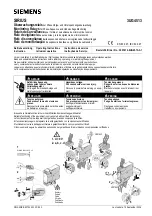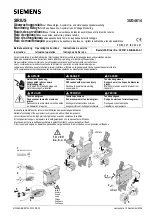
- 1 -
Conseils préliminaires
• La mise en oeuvre de l'appareil doit être
effectuée par une personne spécialisée en
installations électriques, en tenant compte
des prescriptions des différentes normes
applicables (NF, EN, VDE..), notamment
au niveau des risques encourus en cas de
défaillance de l'équipement électrique.
• Respecter les exigences de la norme
EN 60068-2-6 lors du transport, du
stockage et de l'utilisation de l'appareil.
• Toutes interventions sur le boîtier (ouver-
ture du relais, échange ou modification de
composants, soudure etc..) faites par
l'utilisateur annule la garantie.
• Montez l'appareil dans une armoire
électrique à l'abri de l'humidité et de la
poussière.
• Assurez-vous du pouvoir de coupure des
contacts de sortie en cas de charges
inductives ou capacitives.
• L'utilisation de commandes bimanuelles
suppose que par ailleurs l'ensemble des
circuits de la machine réponde aux règles
de sécurité concernant les machines
dangereuses (EN 574, EN 692 et
EN 693).
• Le branchement de la tension d'alimenta-
tion du P2HZ X4P doit être conforme aux
prescriptions § 9 VBG 7n5.1/2
• Pour éviter des interférences inductives ou
capacitives,il est préférable de placer le
câble reliant le P2HZ X4P aux organes de
commande loin des câbles de puissance.
• Utilisez des boutons poussoirs avec des
contacts dorés en raison des faibles
intensités commutées.
• Respectez les schémas de câblage du
relais donnés dans le chapitre "Utilisation".
Domaines d'utilisation
P2HZ X4P répond aux exigences de la norme
EN 574 pour les relais de type III C. Les
commandes bimanuelles sont des dispositifs
qui obligent les opérateurs à avoir les deux
mains situées en dehors de la zone
dangereuse durant la phase dangereuse de
la machine.
Le relais P2HZ X4P est spécialement adapté
pour assurer la fonction de simultanéité et
est utilisable comme relais de comande
bimanuelle selon les directives techniques
pour:
• les preses mécaniques (EN692)
• les presses hydrauliques (EN 693)
ou
• les circuits de sécurité d'après la norme
EN 60204-1
Sicherheitsbestimmungen
• Das Gerät darf nur von Personen installiert
und in Betrieb genommen werden, die mit
dieser Betriebsanleitung und den geltenden
Vorschriften über Arbeitssicherheit und
Unfallverhütung vertraut sind. Beachten Sie
die VDE- sowie die örtlichen Vorschriften,
insbesondere hinsichtlich der Schutzmaß-
nahmen.
• Beim Transport, bei der Lagerung und im
Betrieb die Bedingungen nach EN 60068-
2-6 einhalten (s. technische Daten).
• Durch Öffnen des Gehäuses oder eigen-
mächtige Umbauten erlischt die Gewährlei-
stung.
• Montieren Sie das Gerät in einen Schalt-
schrank; Staub und Feuchtigkeit können
sonst zu Beeinträchtigungen der Funktio-
nen führen.
• Sorgen Sie an allen Ausgangskontakten
bei kapazitiven und induktiven Lasten für
eine ausreichende Schutzbeschaltung.
• Die Zweihandschaltung und die vor- und
nachgeschalteten Teile der Pressensteue-
rung müssen den einschlägigen VDE-
Bestimmungen und den Sicherheitsregeln
EN 574, EN 692 und EN 693 entsprechen.
• Die Versorgungsspannung des Zweihand-
bedienungsrelais darf nur nach der
Ausschalteinrichtung gemäß § 9 VBG
7n5.1/2 angeschlossen werden.
• Verlegen Sie die Verbindungskabel zw.
P2HZ X4P und den Tastern nicht unmittel-
bar neben Starkstromleitungen; es können
sonst induktive und kapazitive Störein-
kopplungen entstehen.
• Verwenden Sie wegen der geringen
Ströme Tasterkontakte mit Goldauflage.
• Das Gerät darf nur wie in den Anschluss-
beispielen im Kapitel „Anwendungen“
angeschlossen werden.
Bestimmungsgemäße Verwendung
P2HZ X4P erfüllt die Anforderung nach
EN 574 Typ III C. Das Zweihandbe-
dienungsrelais zwingt den Bediener einer
Presse zur Vermeidung von Handver-
letzungen die Hände während der gefahrbrin-
genden Schließbewegung außerhalb der
Gefahrenstelle zu halten.
P2HZ X4P ist zum Einbau in Steuerungen für
Pressen der Metallbearbeitung als Baustein
der Gleichzeitigkeit geeignet.
Das Gerät kann als Handschutzeinrichtung
nach den technischen Regeln
• mechanische Pressen (EN 692)
• hydraulische Pressen (EN 693)
oder in
• Sicherheitsstromkreise nach EN 60204-1,
VDE 0113-1
eingesetzt werden.
Safety Regulations
• The unit may only be installed and
operated by personnel who are familiar
with both these instructions and the current
regulations for safety at work and accident
prevention. Follow local regulations
especially as regards preventative
measures.
• Transport, storage and operating
conditions should all conform to
EN 60068-2-6 (see Technical Details).
• Any guarantee is void following opening of
the housing or unauthorised modifications.
• The unit should be panel mounted,
otherwise dampness or dust could lead to
malfunction of the unit.
• Adequate protection must be provided on
all output contacts with capacitive and
inductive loads.
• The two-hand circuit and the connected
parts of the press control must conform to
the relevant safety standard EN 574,
EN 692 and EN 693.
• The operating voltage of the two-hand
relay may only be connected according to
§ 9 VBG 7n5.1/2 (cut-out devices)
• To avoid indirective coupling and capaci-
tance effects, the cables to the two push-
buttons must be run separately to any
power cables.
• Pushbutton contacts should be gold plated
due to the low current output.
• The unit is only to be connected as shown
in the connection diagrams - chapter
“Applications”.
Intended Application
P2HZ X4P fulfils the requirements to EN 574
Type III C. The two-hand relay can be used
to enable a machine operator to avoid hand
injury as the hands are kept out of the
hazardous area during dangerous machine
movements.
The P2HZ X4P has been designed for use as
a means of simultaneous switching for
control on metal processing presses.
The unit can be used as a hand protection
device according to the Technical Safety
Requirements:
• Mechanical presses (EN 692)
• Hydraulic presses (EN 693)
or in
• Safety circuits according to EN 60204-1,
VDE 0113-1
20076-6NL-05
P2HZ X4P
4
D
Betriebsanleitung
4
GB Operating instructions
4
F
Manuel d'utilisation
4
E
Instrucciones de uso
4
I
Istruzioni per l`uso
4
NL Gebruiksaanwijzing


































